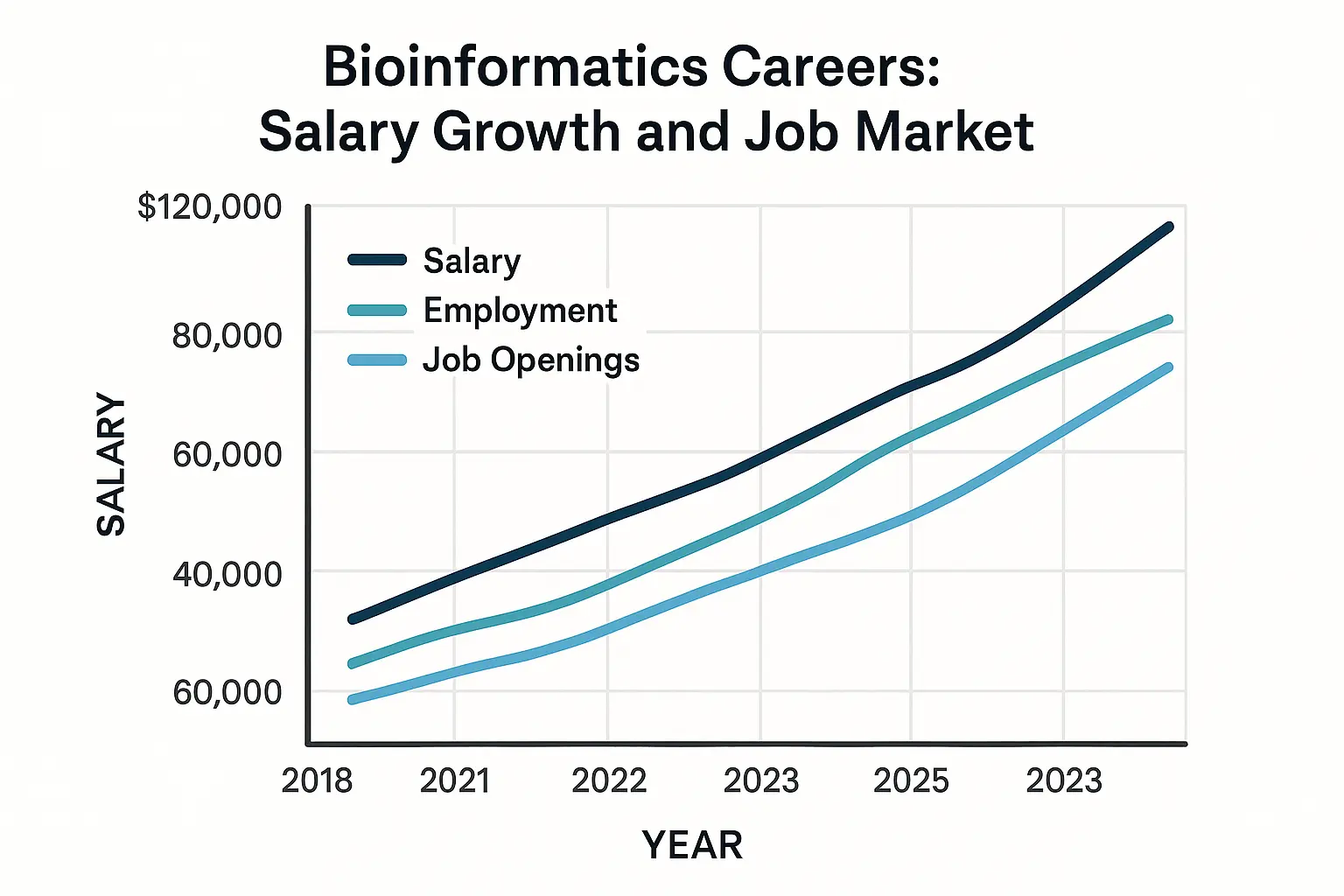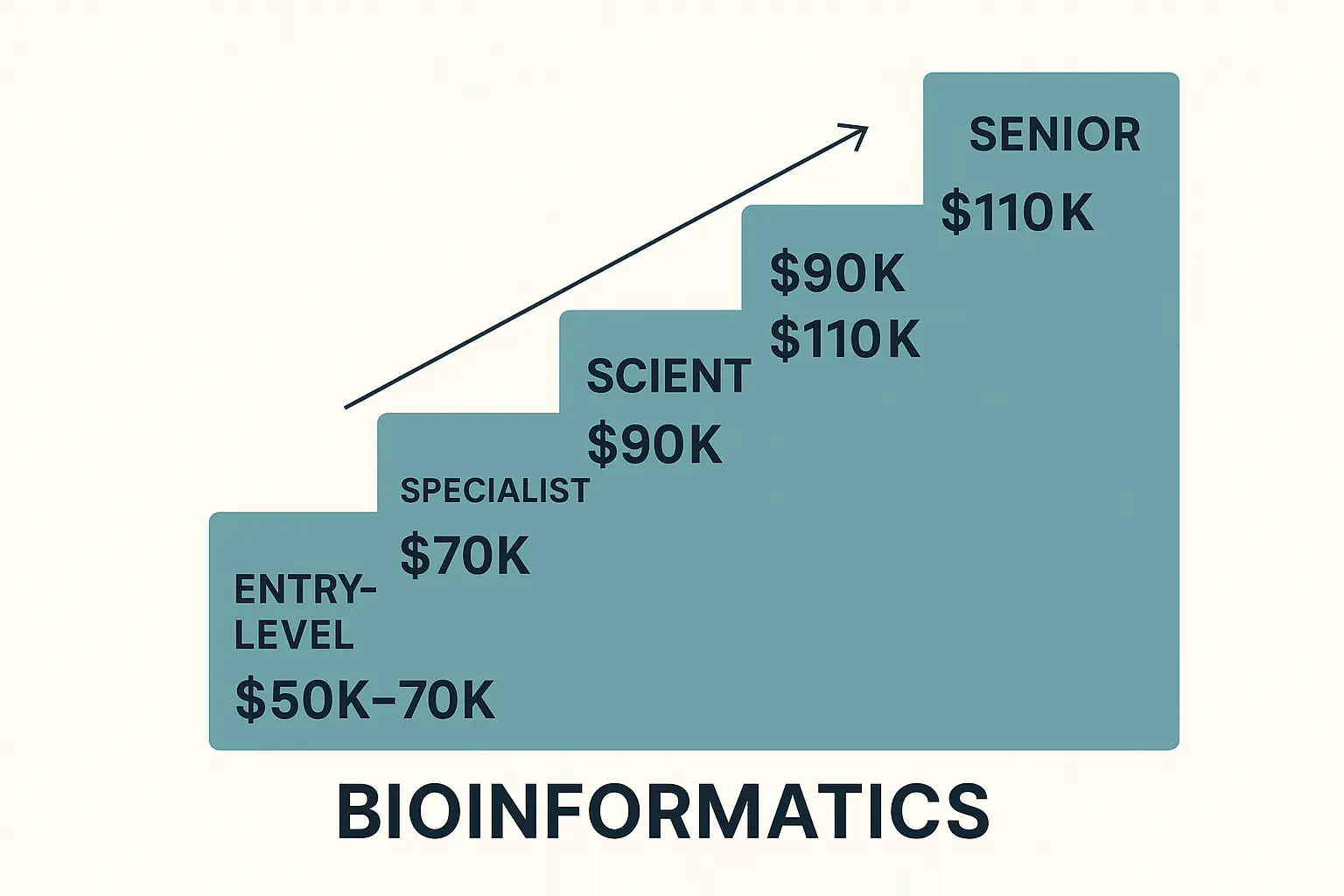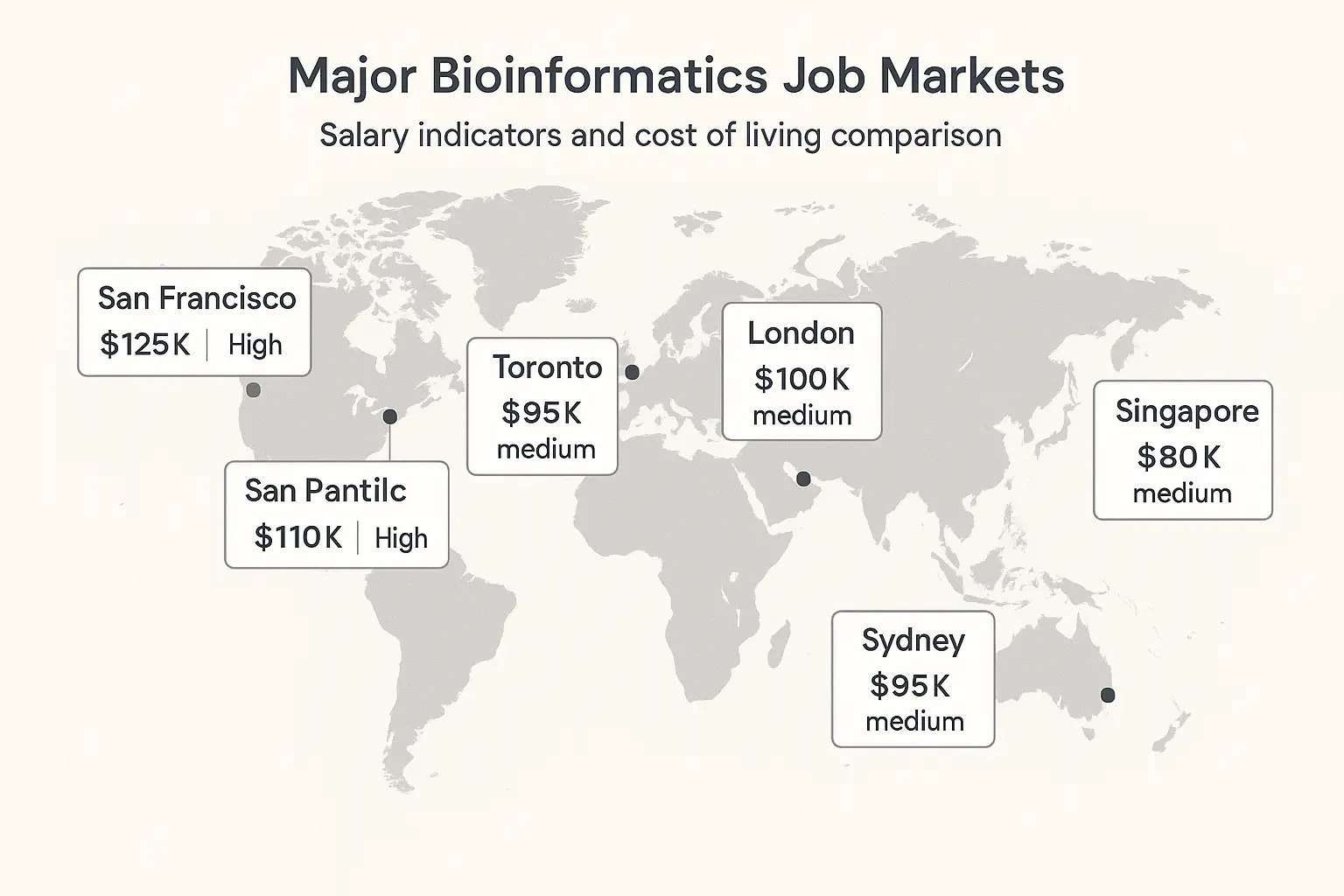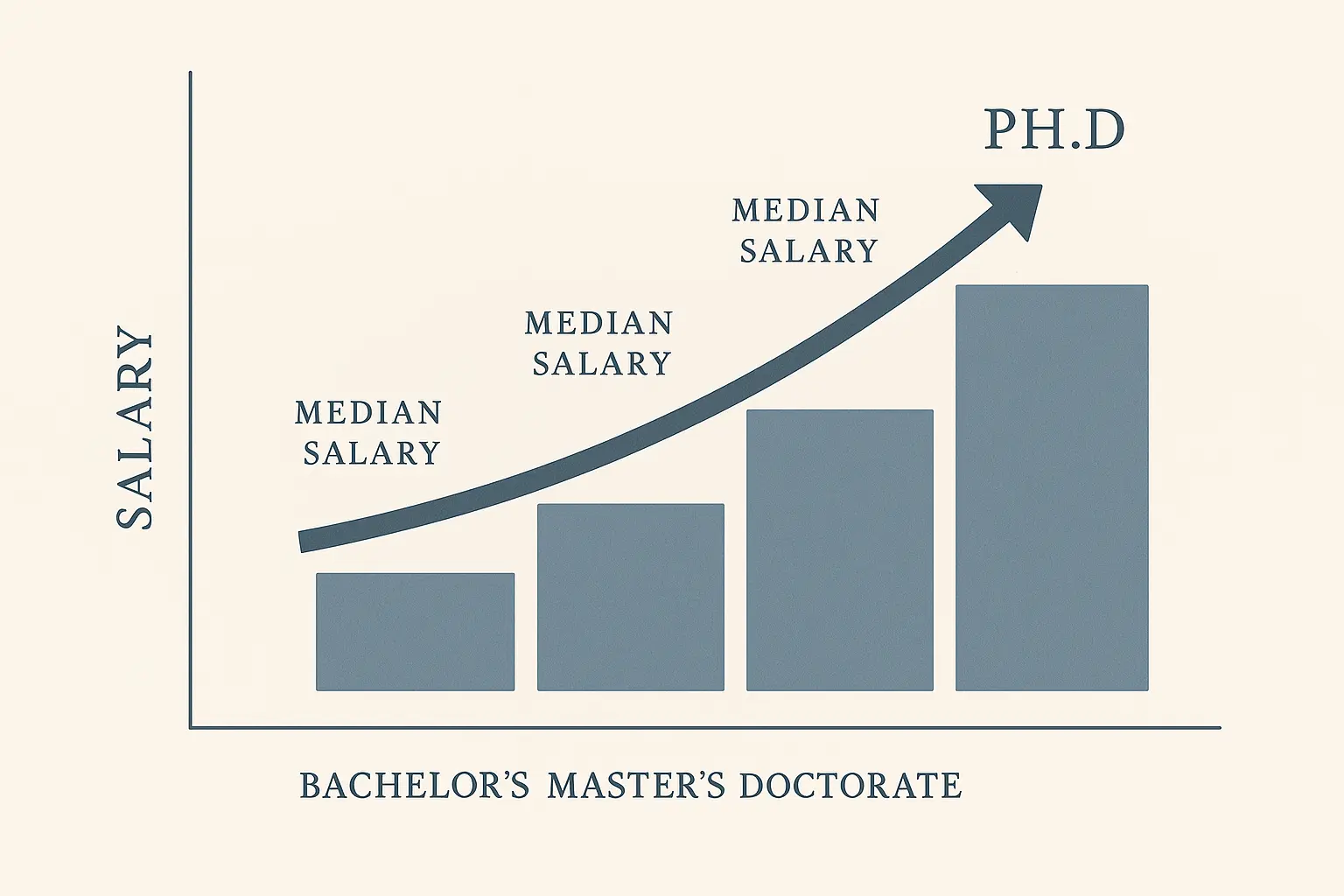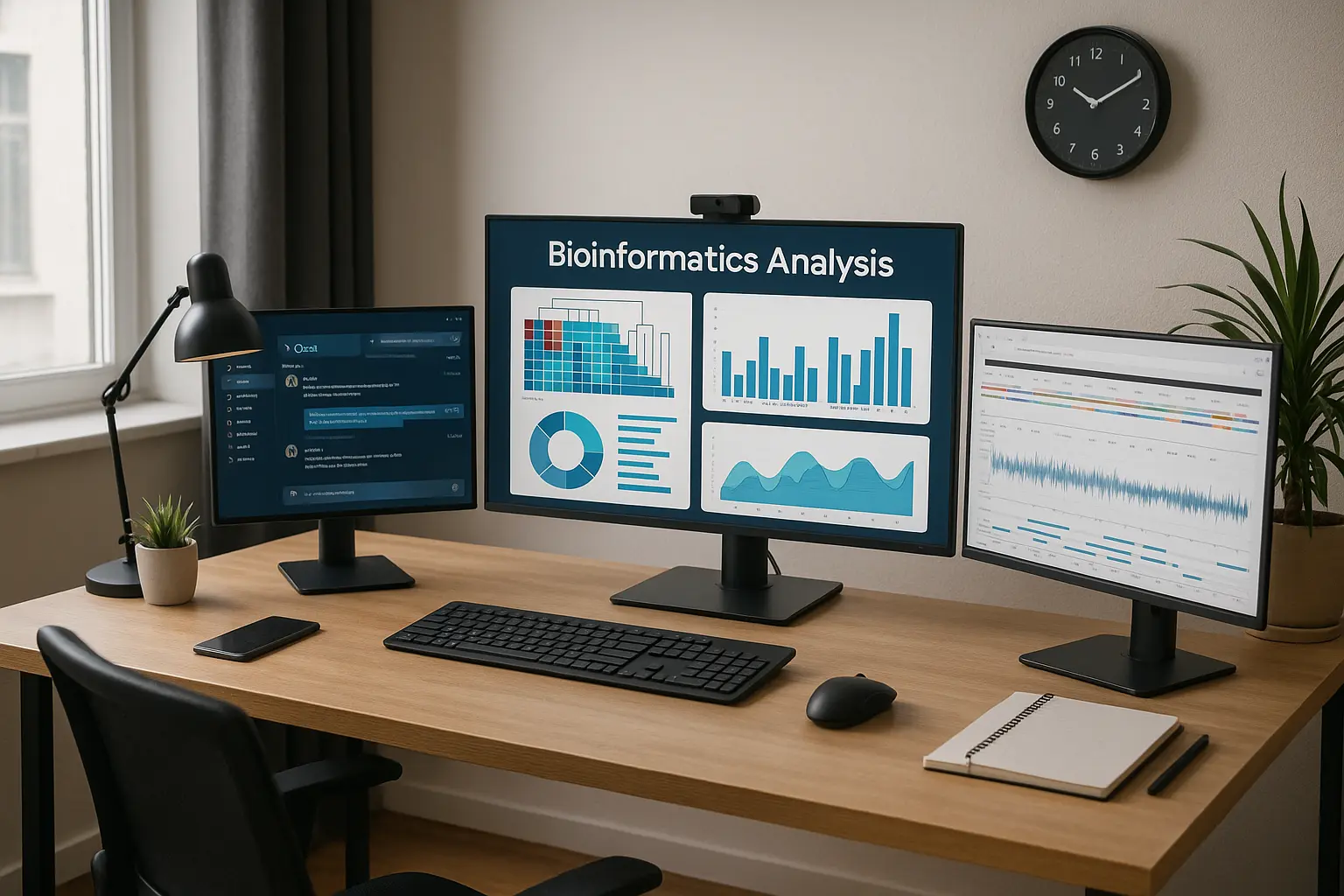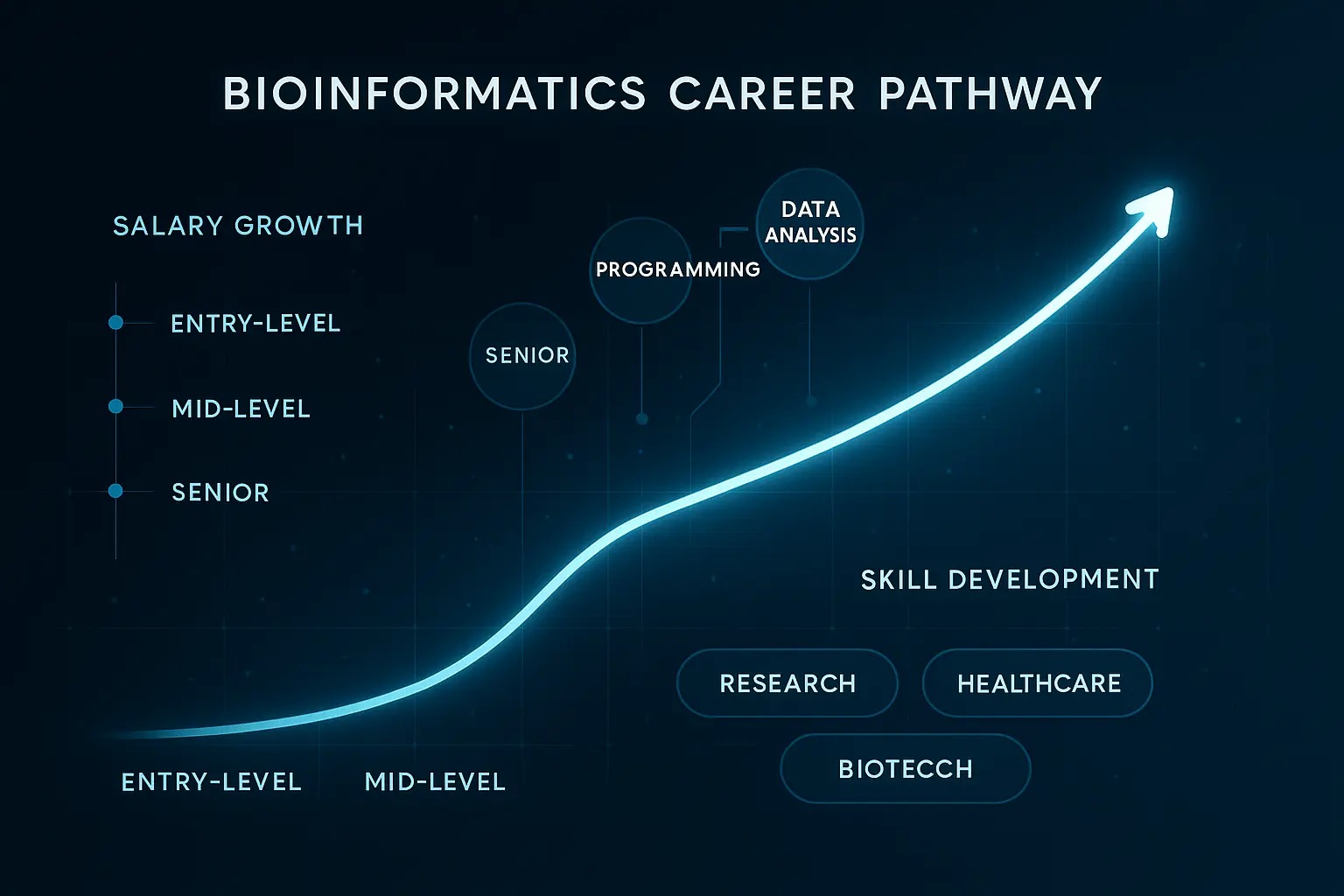When I started in bioinformatics five years ago, explaining my job to family was a nightmare. “I analyze DNA… with computers… for drug companies.” Now? Everyone wants to know how to get into this field—and honestly, I don’t blame them.
The money’s gotten really good. We’re talking $65k starting salaries that can hit $200k+ if you play your cards right. But here’s the thing nobody tells you: those salary surveys you’re reading? They’re basically useless without context. According to Drexel University, the average bioinformatician salary hovers around $80,000, while professionals with master’s degrees earn closer to $100,000 annually. The Bureau of Labor Statistics projects 15% growth through 2032, creating serious upward pressure on salaries across all experience levels.
Table of Contents
-
Current Market Reality Check
-
Entry-Level: What Your First Paycheck Actually Looks Like
-
Mid-Career: The $100k+ Club
-
Location, Location, Location (But Not Like You Think)
-
Industries That Actually Pay Well
-
Education: What’s Actually Worth the Money
-
Skills That Actually Matter
-
Scientist vs. Bioinformatician: The Title Game
-
Negotiation: What Actually Works
-
Freelance and Consulting: The Side Hustle
-
Long-Term Financial Planning
-
Final Thoughts
TL;DR
-
Entry-level bioinformaticians start between $65,000-$85,000, but location and industry make huge differences
-
Mid-career professionals with 3-7 years experience typically earn $90,000-$130,000
-
Pharmaceutical companies consistently offer the highest starting salaries compared to academia or government
-
Major biotech hubs like San Francisco and Boston pay 20-30% more than national averages
-
Specializing in machine learning, clinical genomics, or drug discovery can boost your salary by 15-25%
-
Remote work has opened up higher-paying opportunities regardless of where you live
-
Bioinformatics scientists with PhDs earn 10-20% more than general bioinformaticians
-
Independent consultants can charge $75-$200 per hour for specialized project work
-
Total compensation packages often exceed base salaries by 30-50% when including equity and benefits
Current Market Reality Check
Look, I’m not going to sugarcoat this – we’re in a golden age for bioinformatics salaries, and it’s kind of wild to watch. The demand for professionals who can bridge biology and data science has absolutely exploded. Companies are desperately seeking people who can handle massive datasets, apply machine learning to genomic data, and translate complex analyses into actionable insights.
What’s driving all this? Data. Insane amounts of it. Genomic data is doubling every 12-18 months, and companies are drowning in information they can’t interpret. They need people who can bridge the gap between wet lab biology and serious computational work. That’s us, and that’s why the Bureau of Labor Statistics is projecting 15% growth through 2032.
According to Biotecnika, the U.S. Bureau of Labor Statistics projects a 15% growth rate for bioinformatics-related jobs such as biological scientists and data scientists between 2022 and 2032 – much faster than average job growth. This rapid expansion has created a competitive hiring environment where employers especially want people who can work with cloud platforms, handle multi-omics data, use machine learning and AI, and develop and interpret computational analyses.
But here’s what those growth projections don’t tell you – the skill requirements are shifting fast. It’s not enough to know R and basic statistics anymore. Companies want cloud computing, machine learning, and the ability to work with multi-omics datasets that would’ve crashed servers a few years ago.
|
Market Growth Indicators |
2024 Status |
2032 Projection |
|---|---|---|
|
Job Growth Rate |
15% |
Continued expansion |
|
Average Starting Salary |
$65,000-$85,000 |
Expected 20-30% increase |
|
Data Generation Rate |
Doubling every 12-18 months |
Exponential growth |
|
Global Market Size |
$12.4 billion |
$23.2 billion |
Entry-Level: What Your First Paycheck Actually Looks Like
Forget everything you’ve read about “average” starting salaries. Your first bioinformatics job will pay somewhere between $65,000 and $85,000, but that range is basically useless without context.
Here’s what actually matters: Sarah graduated with her master’s last year and had two offers. Academic medical center in Boston: $65,000. Pharma company down the street: $78,000 plus a $5,000 signing bonus. Same degree, same city, $18,000 difference in first-year compensation. The pharma job also came with equity that could be worth another $10,000 annually if the company hits its milestones.
Your educational background determines your starting point more than anything else. Bachelor’s degree? You’re looking at the lower end of that range, probably $65,000-$70,000. Master’s degree? Add $10,000-$15,000 to that immediately. PhD? You might skip “entry-level” entirely and start in the $85,000-$95,000 range.
For professionals considering the educational investment, understanding whether getting a college degree is worth it becomes crucial when evaluating potential bioinformatics career paths and their corresponding salary ranges.
Industry makes a huge difference too. Pharmaceutical companies consistently pay the most because they have the budgets and they’re desperate for talent. Biotech startups come next – they might match pharma on base salary but the equity could make you rich or leave you with worthless paper.
According to Drexel University’s career data, specific entry-level roles show significant variation: Bioinformatics Analysts average $69,000, while Bioinformatics Technicians earn around $75,635 on average, and Bioinformatics Engineers command $102,146 average salaries.
Government and academic positions typically start around $65,000, but don’t dismiss them. The benefits are often incredible, job security is real, and you’ll get research experience that can boost your earning potential down the road.
Mid-Career: The $100k+ Club
After 3-7 years, you’re looking at $90,000-$130,000, and this is where your career choices really start to matter. Are you becoming a deep technical specialist, or moving toward project management? The paths pay differently.
I know a guy who spent five years becoming the go-to person for GWAS analysis at his company. When he switched jobs last year, he got a $35,000 bump just because that specific skill set is in crazy demand. Meanwhile, another colleague who stayed more generalist took longer to break $100,000 but now manages a team of six people.
Specialization pays. Machine learning applications in genomics can add 15-25% to your bioinformatician salary. Clinical genomics, drug discovery analytics, regulatory compliance – these aren’t just buzzwords, they’re premium pay categories.
The jump to senior scientist or principal investigator level ($140,000-$200,000+) requires strategic thinking. You can’t just wait for promotions. You need to build expertise in areas companies actually value, publish papers that get noticed, or develop tools that other people use.
Management is a different beast entirely. Bioinformatics managers and directors earn $150,000-$300,000, with total compensation packages that often exceed base salaries by 30-50%. But you’ll spend your time on budgets and personnel issues instead of actual analysis. Make sure that’s what you want before going down that path.
Take Michael, who spent 5 years as a computational biologist before transitioning to a team lead role. His technical salary peaked at $125,000, but after moving into management, his total compensation jumped to $165,000 base salary plus equity and bonuses worth an additional $40,000 annually. However, he now spends only 20% of his time on actual data analysis compared to 80% in his previous role.
Location, Location, Location (But Not Like You Think)
San Francisco, Boston, and San Diego consistently offer the highest salaries – we’re talking 20-30% above national averages. A $90,000 job in Austin might pay $115,000 in Boston. But before you pack your bags, factor in cost of living differences. That extra $25,000 might not go far when rent alone costs $1,000+ more per month.
The real opportunities are in places like Austin, Seattle, and Research Triangle Park. These markets offer competitive salaries without the crushing cost of living you’ll find in traditional biotech hubs. I’ve seen professionals make lateral moves to these areas and effectively get 20-30% raises just from the cost arbitrage.
Remote work changed everything, though. You can now work for a San Francisco company while living somewhere reasonable. Some companies are adjusting salaries based on location, but plenty aren’t. The opportunities are there if you know how to find and negotiate them.
|
Geographic Region |
Average Salary Range |
Cost of Living Index |
Net Value Score |
|---|---|---|---|
|
San Francisco Bay Area |
$115,000-$160,000 |
180 |
7.2/10 |
|
Boston |
$105,000-$145,000 |
150 |
8.1/10 |
|
Austin |
$90,000-$125,000 |
110 |
8.7/10 |
|
Research Triangle Park |
$85,000-$120,000 |
105 |
8.5/10 |
|
Remote (National) |
$80,000-$135,000 |
Variable |
9.0/10 |
Industries That Actually Pay Well
Pharma wins, hands down. They have the money and they’re willing to spend it. Pharmaceutical companies consistently pay the most, and it’s not even close. They have the budgets to compete for top talent, and they’re willing to pay premium salaries for professionals who can accelerate drug discovery and development processes.
Big pharma also offers excellent benefits packages, including comprehensive health insurance, retirement contributions, and often stock options or profit-sharing programs. The work tends to be more applied and commercially focused, which some people love and others find limiting.
Biotech startups are gambling. Base salaries might match pharma, but the real money is in equity. I know people who became millionaires from startup equity, and others who watched their options expire worthless. High risk, potentially high reward.
Startups also offer more diverse responsibilities and faster career advancement opportunities. You might find yourself wearing multiple hats and gaining experience that would take years to accumulate at a larger company.
Academic medical centers and government pay less upfront but offer other valuable benefits. Job security is generally better, the work tends to be more research-focused, and there are often opportunities for publication and conference presentations that can boost your professional profile.
Government positions come with excellent benefits, clear advancement pathways, and the satisfaction of working on projects that benefit public health. The pace might be slower, but work-life balance is often better than what you’ll find in industry.
Education: What’s Actually Worth the Money
A bachelor’s degree gets you in the door, but it’s becoming table stakes rather than a competitive advantage. Most entry-level positions now expect at least a bachelor’s degree, and many prefer candidates with relevant coursework in both biology and computer science.
Master’s degrees typically add $10,000-$20,000 to starting salaries and open doors that bachelor’s degrees don’t. The ROI on a master’s degree in bioinformatics is generally excellent, especially if you can complete it while working or through a program that includes industry partnerships and internship opportunities.
For professionals considering advanced education, understanding the cost of a college degree versus potential salary increases becomes a critical financial planning decision in bioinformatics career development.
PhDs are interesting. You’ll spend 4-6 years in school plus potentially 1-3 years as a postdoc earning $50,000-$65,000. But PhD holders often skip entry-level positions entirely and start in roles that would take bachelor’s or master’s degree holders several years to reach. The long-term earning potential is typically much higher, especially for positions in research leadership or specialized technical roles.
Education ROI Checklist:
-
Calculate total education costs including opportunity cost
-
Research salary premiums for each degree level in your target market
-
Consider program quality and industry connections
-
Evaluate work-study options to minimize debt
-
Factor in long-term career advancement opportunities
-
Assess personal learning preferences and career goals
Skills That Actually Matter
Machine learning and AI applications are exploding right now. If you can apply deep learning to genomic data or develop predictive models for drug discovery, you’re looking at serious salary premiums. These specialized skills in areas like GWAS analysis, structural bioinformatics, or regulatory compliance can justify premium compensation requests.
Cloud computing isn’t optional anymore. AWS, Google Cloud, Azure – pick one and get certified. Companies are moving everything to the cloud and they need people who can manage these systems efficiently. Cloud computing skills are becoming essential rather than optional, and AWS, Google Cloud, and Azure certifications can add $10,000-$20,000 to your bioinformatician salary.
Programming languages matter, but it’s not just about knowing Python and R anymore. Java, Scala, even Julia are becoming valuable. More importantly, you need to write efficient, scalable code that can handle massive datasets.
Don’t overlook SQL. Most bioinformatics work involves querying databases, and being able to write complex queries efficiently sets you apart from other candidates.
High-Value Skills Checklist:
-
Master Python and R for data analysis
-
Obtain cloud computing certifications (AWS/GCP/Azure)
-
Learn machine learning frameworks (TensorFlow, PyTorch)
-
Develop SQL database management skills
-
Gain experience with specialized tools (BLAST, Galaxy, Bioconductor)
-
Understand regulatory compliance requirements
-
Build portfolio of open-source contributions
Scientist vs. Bioinformatician: The Title Game
“Bioinformatics Scientist” typically pays 10-20% more than “Bioinformatician.” We’re looking at $95,000-$160,000 for mid-level scientist positions versus $90,000-$130,000 for general roles. The bioinformatics scientist salary reflects additional responsibilities and higher educational requirements.
Scientist positions usually require more independent research, publication expectations, and often involve leading projects or mentoring junior staff. The work tends to be more hypothesis-driven and research-focused rather than purely analytical or support-oriented.
According to Drexel University, Bioinformatics Scientists earn an average of $90,000 annually, representing the foundation for senior-level growth potential.
Most scientist positions prefer or require PhDs, which limits the candidate pool but also means faster advancement for qualified people. Academic bioinformatics scientists often accept lower base salaries ($80,000-$120,000) in exchange for research freedom, publication opportunities, and potential patent royalties.
Postdoc positions typically pay $50,000-$65,000, which seems low compared to industry salaries. However, postdocs provide crucial research experience and publication opportunities that can lead to substantial salary jumps when transitioning to industry scientist roles.
Professionals transitioning between academic and industry roles often need to handle credential verification efficiently, making services like replacing a lost diploma crucial for maintaining career momentum during job transitions Dr. Jennifer Chen transitioned from a postdoc position earning $55,000 to a Senior Bioinformatics Scientist role at a biotech company earning $145,000 base salary plus equity. Her three years of postdoc research and four first-author publications were key factors that justified the scientist-level hire rather than a standard bioinformatician position.
Negotiation: What Actually Works
Do your homework first. Glassdoor, PayScale, and industry-specific salary surveys provide baseline information, but don’t stop there. Talk to people in similar roles, attend industry meetups, and join professional organizations where salary discussions happen more openly.
LinkedIn can be incredibly valuable for this research. Look at professionals with similar backgrounds and experience levels, and don’t be afraid to reach out for informational interviews. Most people are willing to share general salary ranges if you approach them professionally.
Specialized skills matter in negotiations. GWAS analysis, structural bioinformatics, regulatory compliance – these justify premium pay requests. Publications, patents, and open-source contributions carry significant weight, especially for scientist-level positions. These demonstrate your ability to contribute original research and thought leadership, which companies value highly.
Don’t fixate on base salary alone. Equity packages, signing bonuses, professional development allowances, and flexible work arrangements can add significant value to your total compensation package. Sometimes a company can’t budge on salary but has flexibility in other areas.
Health benefits, retirement contributions, and vacation time also have real monetary value. A company with excellent health insurance might effectively be paying you $5,000-$10,000 more per year than a company with basic coverage.
Salary Negotiation Checklist:
-
Research market rates for your specific role and location
-
Document your unique skills and accomplishments
-
Prepare 3-5 specific examples of your value contribution
-
Calculate total compensation value, not just base salary
-
Practice your negotiation conversation beforehand
-
Have backup options or competing offers if possible
-
Be prepared to negotiate non-salary benefits
Freelance and Consulting: The Side Hustle
Independent bioinformatics consultants typically charge $75-$200 per hour, with rates varying based on specialization, experience, and project complexity. Specialized skills in areas like clinical trial data analysis, regulatory submissions, or proprietary algorithm development command the highest rates.
The key to successful consulting is building a reputation for delivering high-quality work on time and within budget. Word-of-mouth referrals are incredibly valuable in this field, and satisfied clients often become repeat customers or refer you to other opportunities.
Pharmaceutical companies increasingly offer project-based contracts ranging from $150,000-$300,000 for 6-12 month engagements. These projects often involve specific deliverables like developing analysis pipelines, conducting meta-analyses, or supporting regulatory submissions.
Biotech companies also offer shorter-term projects, typically 3-6 months, with compensation ranging from $75,000-$150,000. These might involve proof-of-concept studies, pilot analyses, or specialized technical implementations.
Many professionals combine part-time consulting with full-time employment, significantly increasing their total annual income while building diverse experience portfolios. This approach requires careful time management and clear agreements with your primary employer about outside work.
Some companies are open to employees taking on consulting projects during evenings and weekends, especially if the work doesn’t compete directly with their business. This can be an excellent way to build consulting experience and client relationships while maintaining the security of a full-time position.
Long-Term Financial Planning
When evaluating job offers, I always tell people to look beyond the base salary number. Equity packages, retirement contributions, health benefits, and professional development allowances can represent 20-40% of your total compensation value. That $120,000 salary with excellent benefits might actually be worth more than a $130,000 salary with basic coverage.
Stock options and equity packages deserve special attention in biotech and pharma companies. I’ve seen colleagues make six-figure gains from company acquisitions or IPOs, but I’ve also seen options expire worthless. Don’t count on equity as guaranteed income, but don’t ignore its potential value either.
Remote work capabilities allow you to optimize earning potential by working for high-paying companies while living in lower-cost areas. A San Francisco bioinformatician salary in a mid-sized city can dramatically improve your quality of life and savings rate.
However, many companies are adjusting salaries based on employee location, so this arbitrage opportunity might not last forever. If you’re considering this strategy, move quickly and be prepared to justify your value regardless of where you live.
Diversifying your income through consulting, teaching, or developing bioinformatics tools can provide both financial security and career flexibility. I know professionals who earn an extra $20,000-$50,000 annually through part-time consulting or online course creation.
Building a strong portfolio of published research, open-source contributions, and industry collaborations significantly enhances your negotiating power and creates opportunities for additional income streams. These investments in your professional reputation pay dividends throughout your career.
Professionals building consulting businesses often need professional displays for client meetings, making resources about framed college diploma display options valuable for establishing credibility in business settings.
Long-Term Financial Planning Checklist:
-
Calculate total compensation value for all job offers
-
Evaluate equity packages and vesting schedules
-
Build emergency fund covering 6-12 months expenses
-
Diversify income through consulting or side projects
-
Invest in continuing education and certifications
-
Track industry salary trends and adjust expectations
-
Plan for career transitions and skill upgrades
Final Thoughts
The bioinformatics salary landscape offers tremendous opportunities for professionals willing to continuously develop their skills and strategically plan their careers. Starting salaries of $65,000-$85,000 can grow to $200,000+ for senior professionals, but success requires more than just technical competence.
Geographic location, industry sector, and specialization choices all significantly impact earning potential. The shift toward remote work has created new opportunities for optimizing compensation while maintaining quality of life, though companies are adapting their strategies accordingly.
For professionals considering whether to pursue advanced degrees in bioinformatics, exploring different types of degrees and their corresponding salary impacts becomes essential for making informed career investment decisions.
What excites me most about this field is how the demand continues to outpace supply. The 15% projected growth through 2032 means we’re likely to see continued upward pressure on salaries, especially for professionals who stay current with emerging technologies like AI/ML applications and cloud computing.
As the field evolves rapidly, professionals may need to consider getting a college degree in emerging specializations or pursuing additional certifications to maintain competitive salary positioning in the bioinformatics market.
The key to maximizing your bioinformatician salary lies in strategic skill development, building a strong professional network, and understanding the total value of compensation packages rather than focusing solely on base salary numbers. Whether you choose the traditional employment path or explore consulting and freelance opportunities, the financial prospects in bioinformatics remain exceptionally strong for dedicated professionals.


